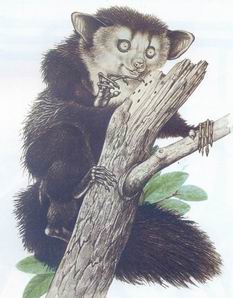The name “Primate”, which means “First”, was proposed by the great Swedish naturalist, Carl von Linne, indicating the inclusion of man, the most advanced of all animals in this order. The group is pisible into three suborders, namely, Lemuroidea, Tarsioidea and Anthropoidea, the first two suborders are also collectively termed as Prosimians, meaning “primitive monkeys”. Anthropoidea includes monkeys, apes and man.
TREE SHREWS
Tupaia ferruginea, The Brown Tree Shrew
T. glis, The Common Tree Shrew
T. montana, Mountain Tree Shrew
T. minor, Lesser Tree Shrew
T. nicobarica, Nicobar Tree Shrew
T. gracilis, The Slender Tree Shrew
T. javanica, Small Tree Shrew
T. dorsalis, Striped Tree Shrew
T. tana, Large Tree Shrew
Tree shrews are squirrel-like arboreal and insectivorous animals found in Southeast Asia. They have primate dentition, bony ring surrounding the eye orbits and digits bear claws, not nails. They live solitary or in pairs and mark their territory with urine and fiercely defend it by threat calls, barking and tail flicking.

AYE-AYE(Daubentonia (=Cheiromys) madagascarensis)
They are cat-sized, nocturnal, lemur-like animals weighing only 2 kg and having dark coat. Highly endangered, only 50 inpiduals are left in the wild in Madagascar. They have one pair of chisel-like incisors in the upper jaw as in rodents. Third finger of fore leg is excessively long, bearing a curved claw.
BUSH-BABY

Galago senegalensis
G. alleni,
G. thomasi
G. zanzibaricus
Galagoides demidovii
Euoticus elegantulus
Euoticus inustus
Bush-babies are distributed in Africa south of Sahara from Ethiopia to Mozambique. They are also called night apes or Galagos. Smallest of them is only 11 inches long but the larger species measure 75 cm. They are related to lorises but unlike them are very agile and move on trees with great speed. They are nocturnal creatures having large eyes and acute hearing power and possess a coat of soft, silky fur.
LORISES
Loris tardigradus, Slender Loris.
Nicticebus caucang, Slow Loris.
Nicticebus pygmaeus, Pygmy Slow Loris.

Lorises are found in tropical rain forests of India, Sri Lanka and southeast Asia. They are shy, nocturnal, omnivorous, arboreal and slow moving creatures. Body is about 26 cm long, without tail and weighs about 350 grams. Males are solitary and females with babies.
LEMURS
Lemurus catta,Ring-tailed lemur
L. macaco,Black lemur
L. fulvus, Blue-eyed lemur
L. coronatus, Crowned Lemur
Microcebus coquereli, Mouse lemur
M. rufus
M. murinus
Indri indri, Indri
Propithecus verreaus, Safaika
P. diadema, Safaika
Cynocephalus variegatus, Flying Lemur
Suborder Lemuroidea contains three families, namely, Lemuridae, Indriidae and Daubentoniidae.
Lemurs are restricted to Madagascar. Nocturnal and arboreal creatures, they have large laterally placed eyes, opposable thumb and big toe and a prominent tail that they generally proudly display. Their movement on the ground is an awkward lateral hopping. They are gifted with loud voice that assists them in communication in dense forests.
TARSIERS
Tarsius spectrum
T. bancanus
T. syrichta
They are solitary, nocturnal, insectivorous and arboreal primates that are not larger than a rat. They possess large, forwardly placed eyes for binocular vision. Tarsals of the hind legs are fused and elongated that adds to the length of legs for jumping. Tips of digits are swollen into pads for firm grip on branches of trees. Helped by these adaptations, they move extremely fast from branch to branch in search of insects.